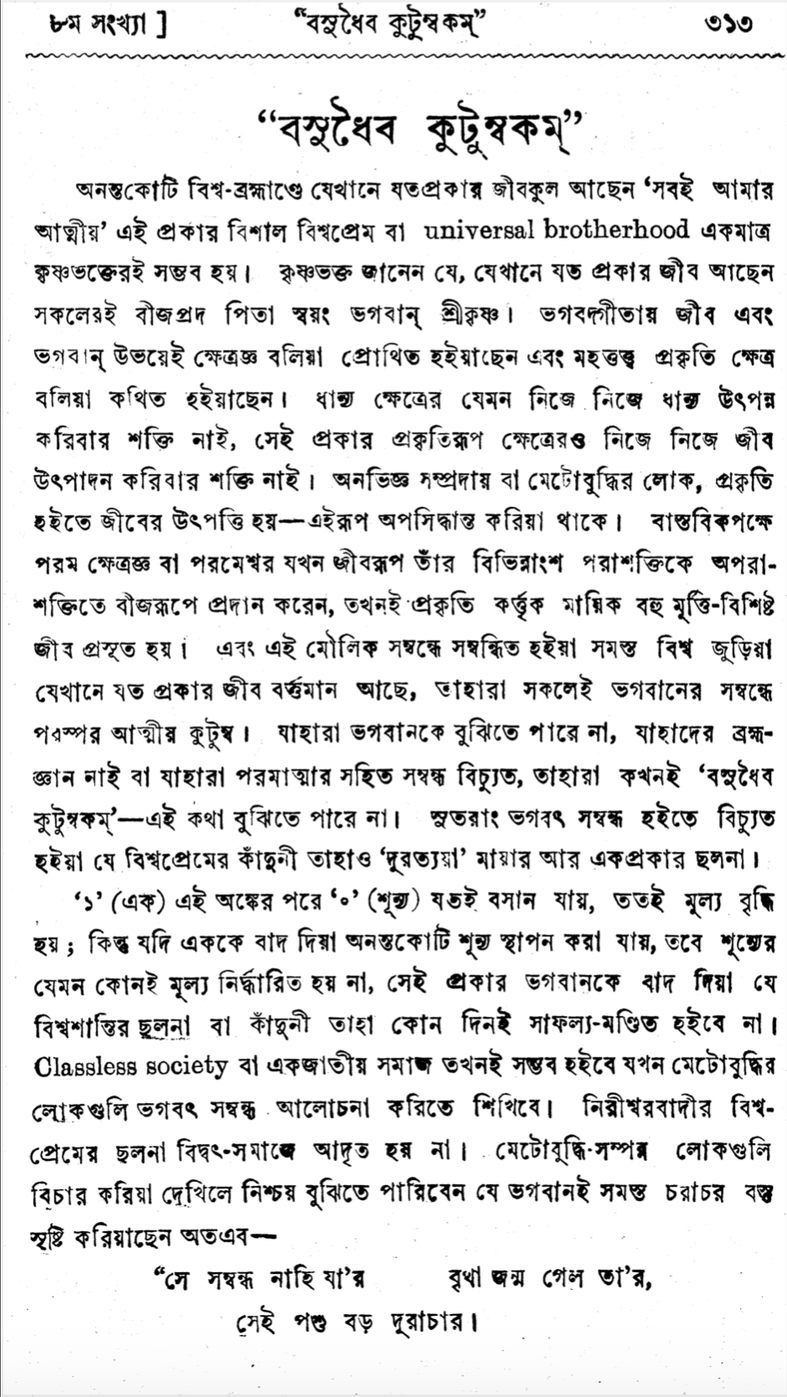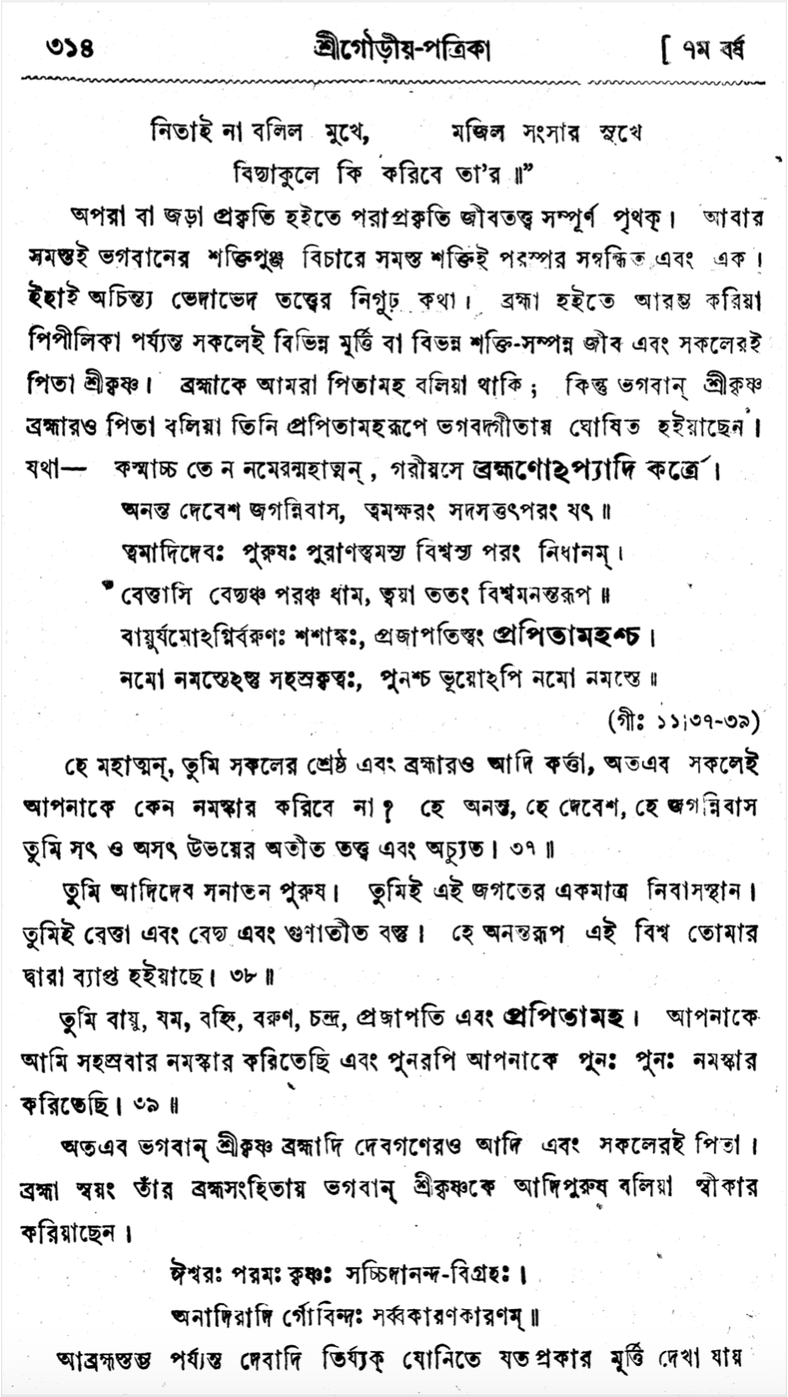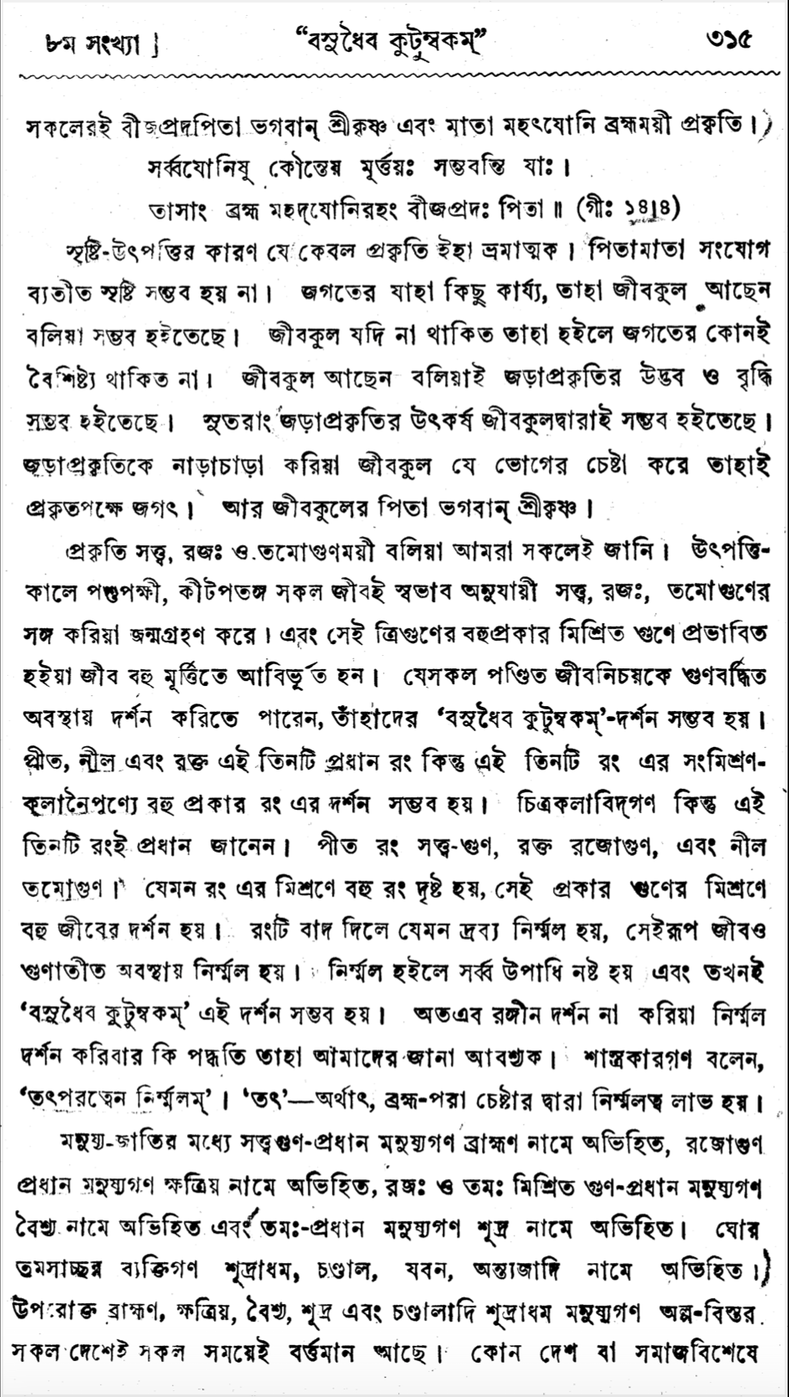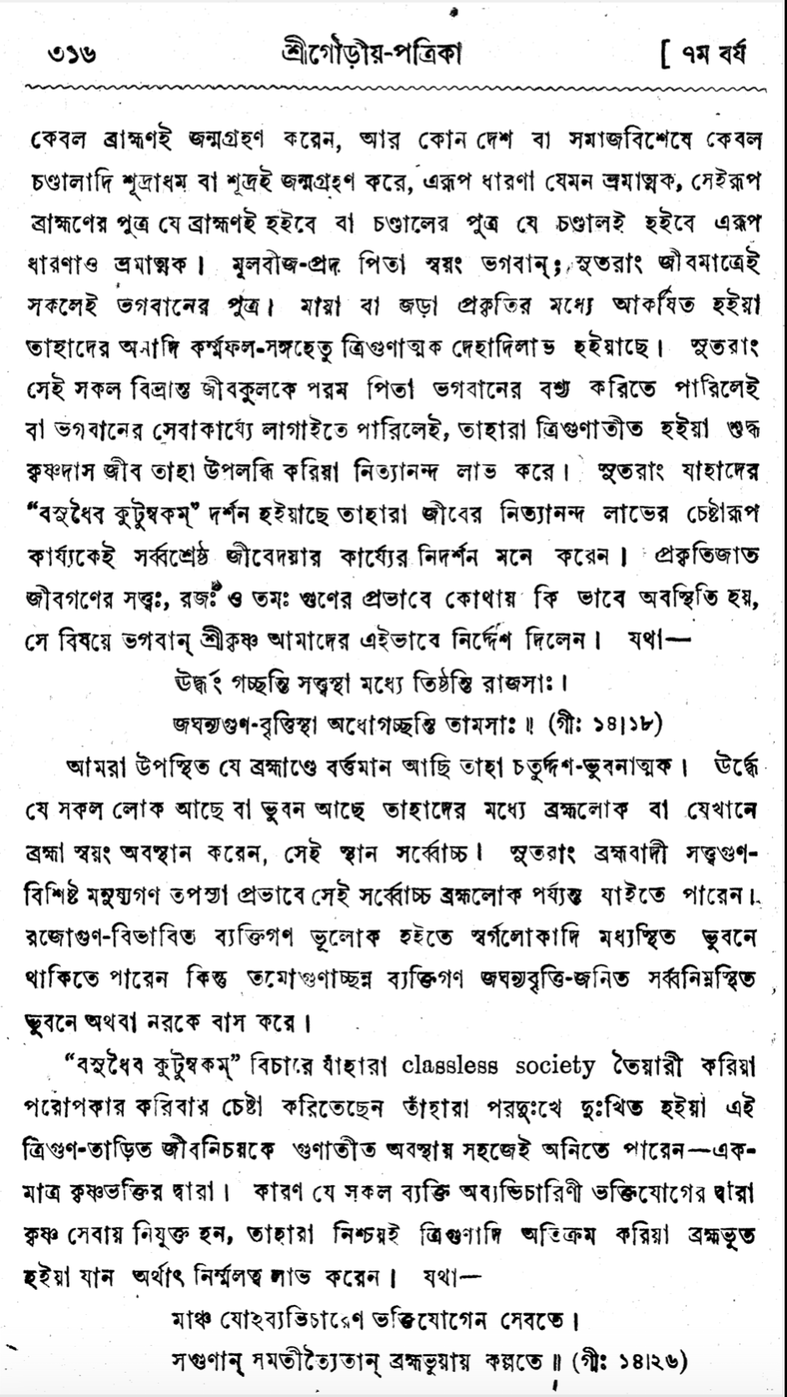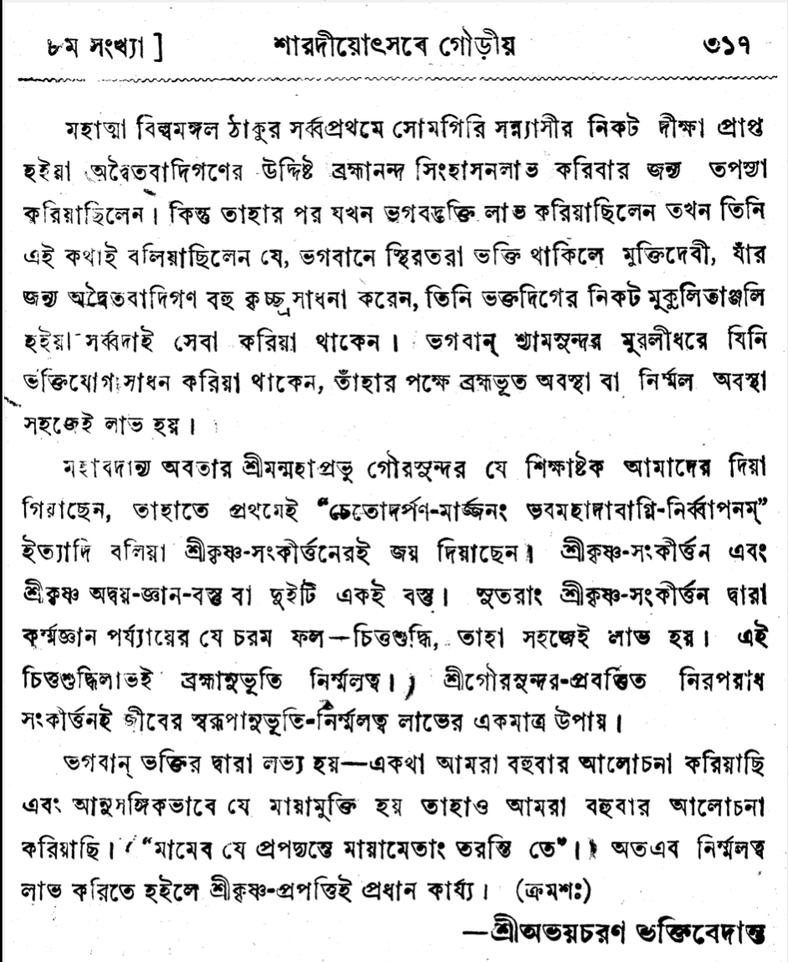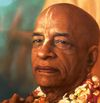Vasudhaiva Kuṭumbakam - "The World is One Family"
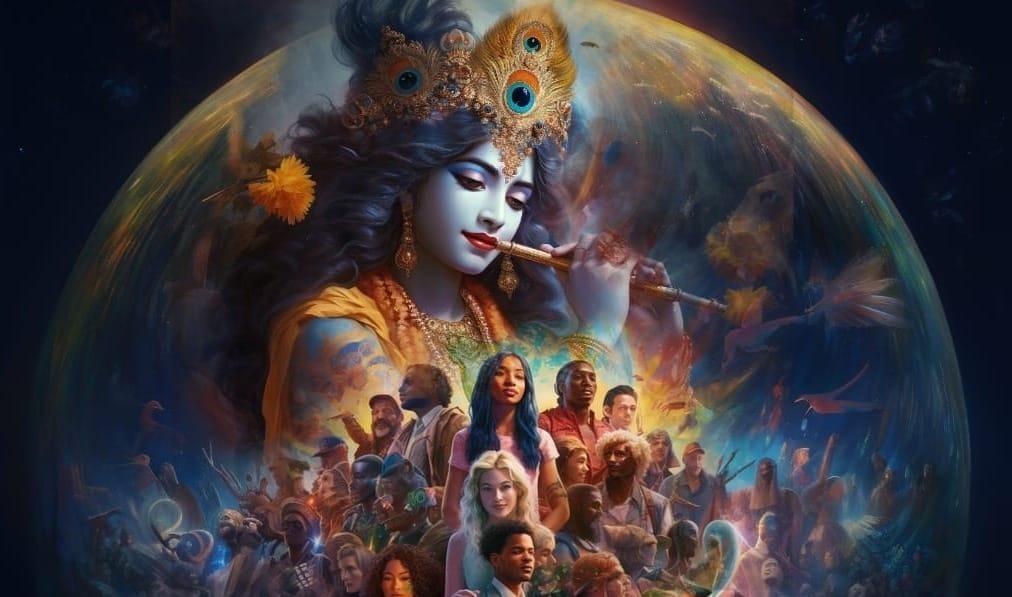
(Translated from Śrī Gauḍīya Patrikā, Year 7, Issue 8 (18/10/55), page 313)
In infinite millions of universes, wherever there are living entities and however many there are, ‘they are all my relations’—this kind of vast viśva-prema, or universal brotherhood, is only possible for devotees of Kṛṣṇa. Devotees of Kṛṣṇa know that however many jīvas there are and wherever they exist, their seed-giving father (bīja-prada pitā) is Svayaṁ Bhagavān Śrī Kṛṣṇa. In Bhagavad-gītā, both the jīva and Bhagavān have been established as kṣetrajña (knowers of the field) and the mahat-tattva prakṛti (the totality of material nature) has been referred to as the kṣetra (the field). Just as a grain field does not have the capacity to grow grain on its own, the field of prakṛti (nature) does not have the power to produce jīvas on its own. People belonging to unacquainted institutions (anabhijña-sampradāya), or those who are engrossed in a materialistic mentality (meṭobuddhi), always conclude that the jīvas arise from prakṛti. The reality is that when the supreme kṣetrajña, or Parameśvara, bestows His vibhinnāṁśa parā-śakti, the jīvas, as seeds into the aparā-śakti, then only are many jīvas of various illusory forms born. And, connected by this fundamental relationship, however many jīvas there are and wherever they may be across all worlds, they are all kin, because of their relationship with Bhagavān. Those who cannot understand Bhagavān, those who do not have brahma-jñāna, or who have lost their connection to Paramātmā, can never understand what ‘vasudhaiva kuṭumbakam’ is. Therefore, the cry for universal brotherhood that lacks a connection to Bhagavān is just another kind of deception of the ‘duratyayā’ (very difficult to overcome) māyā.
The more zeroes you put after a one, the more its value increases; but if you insert infinite millions of zeroes without a one, the zeroes are designated as having no value; likewise, the pretext or cry for world peace that excludes Bhagavān will never be met with success. A classless society, or ekajātīya-samāja, will only be possible when people learn to discuss bhagavat-sambandha (the relationship with God). The atheist’s pretext of universal love is not honored by learned society. If those engrossed in meṭobuddhi would thoughtfully examine matters, they would surely be able to understand that Bhagavān has created all moving and nonmoving entities, which is why it is stated as follows:
“se sambandha nāhi yā’ra vṛthā janma gela tā’ra,
sei paśu baḍa dūrācāra |
nitāi nā balila mukhe, majila saṁsāra sukhe
vidyākule ki karibe tā’ra ||”
[Those who do not have that relationship have spent their lives in vain. They are more ill-behaved than animals. If one has not uttered the name of Nitāi, one sinks into worldly pleasures. What then will all one’s erudition do?]
Jīva-tattva, which is parā-prakṛti (a superior, spiritual energy) is completely different from aparā (“the non-superior”) prakṛti, or material energy. Then again, given the understanding that all that exists is Bhagavān’s multitudinous śakti, all śaktis are mutually related and one. This very principle is the confidential fact of acintya-bhedābheda-tattva. From Brahmā to the ant, all are jīvas with various forms and energies, and the father of them all is Śrī Kṛṣṇa. We call Brahmā our grandfather; but Bhagavān Śrī Kṛṣṇa is Brahmā’s father, which is why He has been declared as the great-grandfather of all in Bhagavad-gītā, as follows:
kasmāc ca te na nameran mahātman garīyase brahmaṇo ’py ādi-kartre |
ananta deveśa jagan-nivāsa tvam akṣaraṁ sad-asat tat paraṁ yat ||
tvam ādi-devaḥ puruṣaḥ purāṇas tvam asya viśvasya paraṁ nidhānam |
vettāsi vedyaṁ ca paraṁ ca dhāma tvayā tataṁ viśvam ananta-rūpa ||
vāyur yamo ’gnir varuṇaḥ śaśāṅkaḥ prajāpatis tvaṁ prapitāmahaś ca |
namo namas te ’stu sahasra-kṛtvaḥ punaś ca bhūyo ’pi namo namas te ||
(Gītā 11.37–38)
O great one, greater even than Brahmā, You are the original creator. Why then should they not offer their respectful obeisances unto You? O limitless one, God of gods, refuge of the universe! You are the invincible source, the cause of all causes, transcendental to this material manifestation. (37)
You are the original Personality of Godhead, the oldest, the ultimate sanctuary of this manifested cosmic world. You are the knower of everything, and You are all that is knowable. You are the supreme refuge, above the material modes. O limitless form! This whole cosmic manifestation is pervaded by You! (38)
You are air, and You are the supreme controller! You are fire, You are water, and You are the moon! You are Brahmā, the first living creature, and You are the great-grandfather. I therefore offer my respectful obeisances unto You a thousand times, and again and yet again! (39) [BBT translations]
Thus Bhagavān Śrī Kṛṣṇa is the origin of even Brahmā and other demigods and is everyone’s father. Brahmā himself has accepted Bhagavān Śrī Kṛṣṇa as the Ādi Puruṣa (Original Person):
īśvaraḥ paramaḥ kṛṣṇaḥ saccidānanda-vigrahaḥ |
anādir-ādir govindaḥ sarva-kāraṇa-kāraṇam ||
From Brahmā down to a blade of grass, all the different species of demigods and animals we see—all of them, their seed-giving father is Bhagavān Śrī Kṛṣṇa and their mother is the mahat-yoni (the great womb) brahma-mayī prakṛti (the energy of nature, which is suffused with and derived from brahma, the Supreme Spirit).
sarva-yoniṣu kaunteya mūrtayaḥ sambhavanti yāḥ |
tāsāṁ brahma mahad yonir ahaṁ bīja-pradaḥ pitā ||
(Gītā 14.4)
It is inherently mistaken to say that the cause of the germination (utpatti) of creation is only prakṛti. Without the union of mother and father, creation is not possible. All the functions of the world are being made possible by the existence of the jīvas. If the jīvas were not here, there would be no speciality to the world. It is because the jīvas are that it is possible for jaḍā-prakṛti (inert natural energy) to be produced and flourish. Therefore, the development of jaḍā-prakṛti is being made possible by the hosts of jīvas themselves. The world is really the enjoyments the jīvas strive for as they stir up that jaḍā-prakṛti. And the father of those hosts of jīvas is Bhagavān Śrī Kṛṣṇa.
We all know prakṛti as being composed of sattva, rajaḥ, and tamoguṇa. At the time of their generation, all living entities—birds, animals, insects, worms—take birth by adopting the association of sattva, rajaḥ, and tamaḥ guṇas as per their nature. Impacted by the qualities produced by many different mixtures of those three guṇas, the jīvas appear in many forms. To see all as ‘vasudhaiva-kuṭumbakam’ is possible for the paṇḍitas who can see the multitudes of jīvas in their various states as orchestrated by the guṇas. Yellow, blue, and red are the primary colors, but given artistic expertise in mixing these three colors, it is possible to see many varieties of colors. But those who know the art of painting know these three colors to be predominant. The color yellow is sattva-guṇa, red is rajo-guṇa, and blue is tamoguṇa. Just as many colors are produced from the mixing of these primary ones, many jīvas are seen to arise from the mixing of the guṇas. Just as removing the color from an object makes it clear and spotless, the jīva situated beyond the guṇas is spotless. When he becomes spotless, all his material designations are destroyed and only then is it possible see all as ‘vasudhaiva kuṭumbakam’. Therefore, it is necessary for us to know how not to see the colored view, but the spotless one. The authors of scripture state: ‘tat-paratvena nirmalam’. ‘Tat’ means brahma, so this means that by endeavors directed towards brahma, spotlessness, or purity, is attained.
Among the human species, those who are predominated by sattva-guṇa are referred to as brāhmaṇas, humans predominated by rajo-guṇa are called kṣatriyas, humans predominated by rajaḥ and tamaḥ are vaiśya, and tama-predominated humans are called śūdras. Persons who are covered by dense tamasa are called śūdrādhama, caṇḍāla, yavana, antyaja, etc. The aforementioned brāhmaṇas, kṣatriyas, vaiśyas, śūdras, caṇḍālas and other śūdrādhamas are more or less always present in every region of the Earth. Just as it is mistaken to think that only brāhmaṇas take birth in a particular country or society and only caṇḍālas and other most fallen types of śūdras take birth in another country or society, it is also mistaken to think that a brāhmaṇa’s son will be a brāhmaṇa, or that a caṇḍāla’s son will be a caṇḍāla. The original seed-giving father is Svayaṁ Bhagavān; therefore, all living entities are Bhagavān’s children. They have been drawn into māyā, or jaḍā-prakṛti, and because of their association with the fruits of their actions since time immemorial, they have obtained bodies composed of the three guṇas. Therefore, only if all those wayward hosts of jīvas can be made subservient to the Supreme Father, Bhagavān, engaged in Bhagavān’s service, can they transcend the three modes and realize that they are pure servants of Kṛṣṇa, thus obtaining eternal bliss (nityānanda). Therefore, those who have had the darśana (vision) of “vasudhaiva kuṭumbakam” believe that the act of trying to get the jīvas to obtain that eternal bliss is the greatest example of compassion for the jīvas. Bhagavān Śrī Kṛṣṇa has explained where and how one becomes situated due to the influence of the modes born of material nature, the jīvas’ sattva, rajaḥ, tamaḥ-guṇas:
ūrdhvaṁ gacchanti sattva-sthā madhye tiṣṭhanti rājasāḥ
jaghanya-guṇa-vṛtti-sthā adho gacchanti tāmasāḥ
(Gītā 14.18)
The present universe we exist in is comprised of fourteen worlds. Of all these lokas, or bhuvanas, that exist in an upward direction, Brahma-loka, or where Brahmā himself resides, is the highest place. Therefore, brahmavādī human beings who are endowed with sattva-guṇa can reach up to that topmost Brahma-loka by the power of their austerities. People influenced by rajo-guṇa can dwell anywhere on or between Earth and the heavenly plants of Svarga-loka. However, people who are covered by tamo-guṇa dwell in the lowest of realms, hell, which is born of all that is vile (jaghanya-janita).
“Those who are organizing a classless society, trying to help others from the perspective of “vasudhaiva kuṭumbakam” can become truly empathetic to the sufferings of others and easily bring the hosts of jīvas who are being tortured by the guṇas to a state beyond the guṇas—only by means of kṛṣṇa-bhakti. The reason for this is that all those persons who are engaged in Kṛṣṇa’s service by means of unalloyed devotional service surely overcome the three guṇas, or attain nirmalatva (purity) as stated:
māṁ ca yo ’vyabhicāreṇa bhakti-yogena sevate
sa guṇān samatītyaitān brahma-bhūyāya kalpate
(Gītā 14.26)
The mahātmā (exalted soul) Bilvamaṅgala Ṭhākura first obtained dīkṣā from the sannyāsī Somagiri and had performed austerities to obtain the throne of brahmānanda aimed for by the advaita-vādīs. However, after that, when he obtained bhagavad-bhakti, he said this same thing, that if one has firm devotion for Bhagavān, Mukti Devī (the personified goddess of liberation) for whom the advaita-vādīs do many intense sādhanās, comes to the devotees with folded hands and serves them constantly. For those who engage in the sādhana of bhakti-yoga for Bhagavān Śyāmasundara Muralīdhara, the state of brahman realization, that spotless state, is easily attained.
In the Śikṣāṣṭaka that the greatly magnanimous incarnation Śrīman Mahāprabhu Gaurasundara gave us, He first declares the glory of śrī kṛṣṇa-saṅkīrtana in the verse “ceto-darpaṇa-mārjjanaṁ bhava-mahā-dāvāgni-nirvāpanam”. Śrī Kṛṣṇa-saṅkīrtana and Śrī Kṛṣṇa, the Absolute Truth, are one. Therefore, by śrī kṛṣṇa-saṅkīrtana, the supreme fruit of the karma and jñāna methods, which is citta-śuddhi (purification of the consciousness), is easily attained. This attainment of citta-śuddhi is the nirmalatva, or sanctity, that is realization of brahma. The performance of saṅkīrtana without offenses as promulgated by Śrī Gaurasundara is the one and only means for the jīva to obtain the sanctity of self-realization.
Bhagavān is attainable via bhakti—this topic we have discussed many times, and we have also discussed many times the fact that liberation from māyā happens concomitantly. “Māmeva ye prapadyante māyām etāṁ taranti te.” Therefore, if one is to attain nirmalatva, then surrendering to Śrī Kṛṣṇa is the main task. (kramaśaḥ – to be continued)
—Śrī Abhaya-caraṇa Bhaktivedānta
